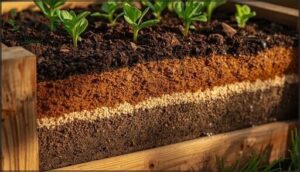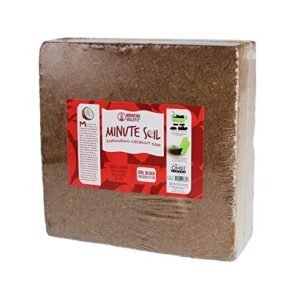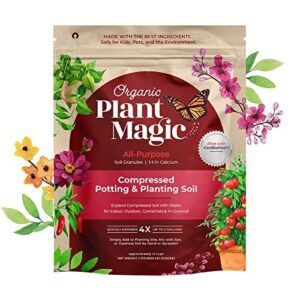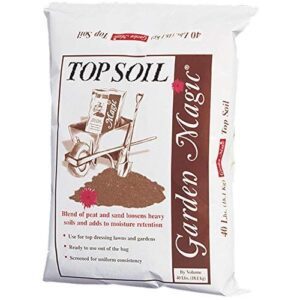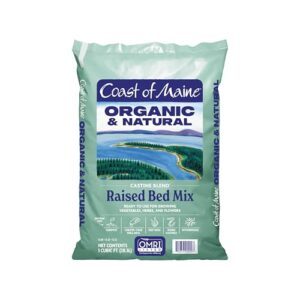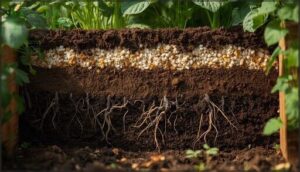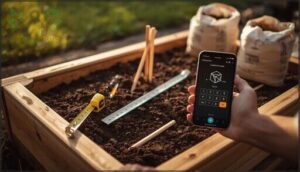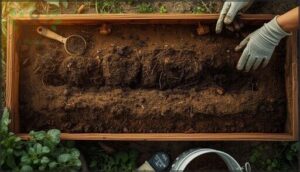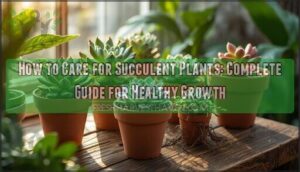This site is supported by our readers. We may earn a commission, at no cost to you, if you purchase through links.
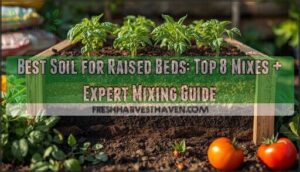
Your raised bed won’t thrive on just any dirt. The soil you choose determines whether your tomatoes develop deep roots or stay stunted, whether your lettuce bolts early or produces tender leaves for weeks.
Most gardeners discover this the hard way—after watching their plants struggle in dense, waterlogged soil or dry out too quickly in a mix that can’t hold moisture.
The difference between disappointing harvests and abundant yields often comes down to three elements working together: structure, drainage, and fertility. Getting your soil right from the start means understanding how these components interact, which products deliver real value, and how to mix them in ratios that match your specific plants and climate.
Table Of Contents
- Key Takeaways
- Key Factors When Choosing Raised Bed Soil
- Essential Components of Raised Bed Soil
- Top 8 Soils and Amendments for Raised Beds
- Calculating and Mixing The Right Soil Blend
- Maintaining and Optimizing Raised Bed Soil
- Frequently Asked Questions (FAQs)
- What is the best soil for raised beds?
- How much soil should be in a raised bed?
- Is topsoil suitable for a raised bed garden?
- Which soil mix is best for a raised garden?
- How to choose a soil mix for a raised bed?
- What is the best mix of soil for raised beds?
- Is there a difference between garden soil and raised bed soil?
- What is the best base for a raised bed?
- How do you fill a raised bed cheaply?
- How often should raised bed soil be replaced?
- Conclusion
Key Takeaways
- Your raised bed soil needs three components working together—40-60% topsoil for structure, 30-50% compost for nutrients, and 10-20% aerators like perlite or vermiculite—to create the drainage, fertility, and texture that determine whether plants thrive or struggle.
- Soil depth requirements change dramatically by crop type: shallow-rooted greens need just 6-12 inches, while deep-rooted vegetables like tomatoes and carrots demand 18-24+ inches to develop proper root systems and access nutrients.
- Maintaining soil pH between 6.0-7.0 increases nutrient availability by 15-25% and prevents common problems like iron deficiency above pH 7.0 or aluminum toxicity below 5.5, making annual testing essential for consistent yields.
- Annual maintenance with 1-2 inches of compost, strategic use of cover crops that add 50-150 kg nitrogen per hectare, and preventing compaction through proper bed access preserves soil structure and fertility without complete replacement for years.
Key Factors When Choosing Raised Bed Soil
Choosing the right soil for your raised bed isn’t as simple as grabbing any bag off the shelf. You’ll need to think about a few critical factors that directly impact how well your plants grow, from the depth of your bed to the pH balance of your mix.
Let’s look at what matters most when selecting soil that sets your garden up for success.
Raised Bed Height Considerations
The height of your raised garden beds shapes everything from ergonomic benefits to soil hydrology and drainage efficiency. Beds measuring 24–30 inches reduce bending strain by up to 60%, making maintenance easier on your back.
Taller frames also support better root development and aeration for deep-rooted crops, but you’ll need to keep in mind structural stability and space efficiency—doubling height doubles soil volume and cost, while beds over 24 inches require reinforced framing to handle lateral pressure.
Remember how gardening and bed height affects comfort.
Plant Type and Root Depth
Before you fill your beds, you need to match soil depth to what you’re growing. Shallow-rooting crops like lettuce and herbs thrive in just 6–12 inches, while medium-rooting vegetables such as peppers and beans need 12–18 inches for proper root development. Deep-rooting plants—tomatoes, carrots, parsnips—demand 18+ inches to access nutrients and establish a sturdy root system.
Here’s how different crops break down by root support needs:
- Leafy greens and herbs – 6–12 inches (shallow root systems)
- Beans, peppers, cucumbers – 12–18 inches (moderate depth)
- Tomatoes, root vegetables – 18–24+ inches (deep rooting)
- Broccoli, Brussels sprouts – 12–18 inches (top-heavy, need anchoring)
- Flowers – varies by species (most perform well at 12 inches)
The soil environment you create directly impacts root expansion—60–70% of most vegetable root mass concentrates in the top 12 inches, where nutrients are richest. Consider that vegetable roots grow quite deep for many plants. If your bed sits on concrete or gravel, roots can’t penetrate beyond the frame, so you’ll need at least 18–24 inches of quality soil depth to compensate for that limitation.
Importance of Soil PH Levels
Matching your soil depth to plant needs is only half the equation—soil pH balance determines whether those roots can actually access nutrients. Most vegetables perform best between pH 6.0–7.0, where nutrient availability peaks. Outside this range, you’ll see problems: iron deficiency above pH 7.0, aluminum toxicity below 5.5, and phosphorus lockout beyond 6.5–7.5.
| pH Range | Nutrient Availability | Plant Performance |
|---|---|---|
| Below 5.5 | Aluminum/manganese toxicity, 70% reduced calcium-magnesium | Stunted roots, 50% less organic matter |
| 6.0–7.0 (Ideal) | Prime nitrogen, phosphorus, potassium uptake | 15–25% higher yields, strong microbial activity |
| Above 7.0 | Iron, manganese, zinc become insoluble | Chlorosis, reduced photosynthesis |
| 5.5–6.0 | Slowed nitrification, limited nitrogen efficiency | Moderate growth, some nutrient stress |
| 7.0–8.0 | Potassium decline, micronutrient deficiency | Poor resilience, yellowing leaves |
Regular soil testing every six months lets you catch pH drift early. Use lime to raise pH in acidic soil or elemental sulfur to lower it in alkaline conditions—but wait three months before retesting. Soil nutrient levels respond directly to microbial activity, which thrives in neutral pH where decomposition and nitrogen fixation peak.
Avoiding Poor-Quality Soil
Once you’ve dialed in pH, you’ll want to steer clear of soil quality pitfalls that sabotage plant health. Fill dirt risks loom large—unregulated sources often harbor heavy metal contamination like lead, zinc, or cadmium, particularly in urban soils near industrial zones. Poor soil quality shows up fast:
- Soil compaction and drainage failure starve roots of oxygen, dropping yields 30–50%
- Nutrient depletion from aging beds reduces microbial biomass by 40%
- Visible soil indicators like crusting, settling over one-third depth, or absent earthworms signal trouble
Test before you buy—soil aeration and organic matter separate winning mixes from dead weight.
Essential Components of Raised Bed Soil
Think of raised bed soil like a recipe—you need the right ingredients in the right amounts to get great results. Each component plays a specific role, from holding moisture to feeding your plants throughout the growing season.
Let’s break down the five essential building blocks that make up a high-performing raised bed soil mix.
Topsoil for Structure and Bulk
Think of topsoil as the foundation of your raised bed—it’s the mineral backbone that provides physical structure and mass. You’ll want loamy topsoil blends with balanced sand, silt, and clay fractions to achieve ideal bulk density between 1.2–1.4 g/cm³.
This soil composition ensures proper water retention and nutrient interaction while maintaining adequate pore space for root growth. In urban systems, quality screened topsoil should make up 45–60% of your total soil volume.
Compost for Nutrients and Fertility
Compost transforms your raised bed into a living nutrient engine, supplying essential nitrogen, phosphorus, and potassium while boosting microbial activity. Quality compost should contain 40–60% organic matter and feature a carbon-to-nitrogen ratio between 20 and 30 for peak nutrient release.
Key Application Practices for Maximum Soil Fertility:
- Apply compost at 30–40% of your total bed volume to increase yields by up to 25%
- Choose mature compost with at least 50% organic matter content for stable nutrients
- Maintain soil pH between 6.0–7.0 to improve nutrient uptake efficiency by 30%
- Add 1–2 inches annually to sustain microbial populations and carbon sequestration
- Test phosphorus levels before application—avoid exceeding 150 lb/acre to prevent runoff
This organic amendment reduces your need for synthetic fertilizer by 30–50% while enhancing long-term fertility.
Substrates: Coconut Coir, Peat Moss, Bark Fines
Substrates form the moisture-managing backbone of your raised bed soil mix, balancing water retention with oxygen flow. Coconut coir holds up to 800% its weight in water while maintaining 30–40% air porosity, making it ideal for consistent irrigation. Peat moss absorbs 10–20 times its weight but brings acidity (pH 3.0–4.5), requiring lime adjustment. Bark fines decompose within 1–2 years, enriching organic matter and improving drainage.
Blending substrates—like combining coir and bark fines—creates enhanced aeration and microbial diversity while supporting sustainability.
Drainage Enhancers: Perlite and Vermiculite
Perlite and vermiculite act as complementary partners in your raised bed soil—perlite boosts drainage and soil aeration, while vermiculite excels at water retention and root zone moisture. Here’s how they function:
- Perlite increases air porosity by up to 50%, preventing compaction and root rot in moisture-sensitive plants
- Vermiculite holds water gradually, serving as a steady reservoir for consistent hydration
- Fine perlite can cut irrigation needs by half in arid climates without harming plant vigor
- Suitable soil amendment ratios include 10–20% perlite for aeration and 20–33% vermiculite for water-sensitive crops
- Perlite’s inert nature suits hydroponic applications, while vermiculite retains nutrients in traditional beds
Blending both creates balanced drainage and moisture control matched to your plants’ needs.
Organic Amendments and Fertilizers
Organic amendments boost your soil’s foundation by feeding microbial activity and cycling nutrients slowly. Compost supplies roughly 1.5% nitrogen, meaning 70 pounds match 10 pounds of 10-10-10 fertilizer, while aged manure requires 200 pounds for similar results. Organic fertilizers improved yield stability by 34.7% in long-term studies.
Apply one cup of high-nitrogen material per 20 square feet when organic matter is low, but watch over-application risks—excess compost raises pH and soluble salts, inhibiting nutrient uptake despite sustainability benefits.
Top 8 Soils and Amendments for Raised Beds
Choosing the right products makes all the difference when building your raised bed soil mix. The following eight soils and amendments represent proven options that address each critical component, from nutrient-rich topsoil to drainage-enhancing minerals.
Here’s what works best for creating a balanced, productive growing environment.
1. FoxFarm Happy Frog Potting Soil
If you’re serious about raising healthy vegetables, FoxFarm Happy Frog Potting Soil delivers the foundation your raised garden beds need. This microbe-infused organic mix combines aged forest products, earthworm castings, and bat guano with mycorrhizal fungi that boost nutrient uptake and strengthen soil structure.
The pH sits between 6.3 and 6.8, supporting ideal plant growth across vegetables, herbs, and flowers. With 0.30% nitrogen and active microbial activity breaking down organic matter, you’ll see vigorous root development and improved environmental suitability.
It’s ready to use straight from the bag, making it ideal for container gardens and raised beds alike.
Best For: Gardeners seeking an organic, ready-to-use potting soil with beneficial microbes for raised beds, containers, and vegetables that promotes strong root growth and nutrient uptake.
- Contains mycorrhizal fungi and active soil microbes that enhance nutrient absorption and support vigorous root development
- Ready-to-use organic blend with balanced pH (6.3-6.8) and quality ingredients like earthworm castings, bat guano, and aged forest products
- Performs exceptionally well across vegetables, herbs, and flowers with strong plant vigor scores and two-year shelf life
- Only available for purchase in Florida, Montana, and Indiana, limiting accessibility for most gardeners
- Higher price point at $22.99 compared to standard potting soils on the market
- Some users reported grass seed contamination issues when mixing with other soil products
2. Minute Soil Coco Coir Grow Medium
For a cost-effective, eco-friendly option, Mountain Valley Minute Soil Coco Coir expands up to 15 times when hydrated, yielding about 15 gallons per block. Its sustainable sourcing from renewable coconut husks makes it a peat-free alternative for raised garden beds.
This compressed organic medium offers excellent coir water retention—holding water up to 8–10 times its weight—while maintaining pH stability between 5.8 and 6.5.
Because it’s raw and non-amended, you’ll need nutrient supplementation through compost or fertilizer. Mix it with topsoil and organic matter to create a soil mix that stays lightweight, resists compaction, and fosters vigorous root growth.
Best For: Gardeners seeking a sustainable, budget-friendly soil amendment that improves water retention and aeration in raised beds while supporting organic growing practices.
- Expands up to 15 times when hydrated, providing excellent value with approximately 15 gallons of medium per $25.41 block
- Superior water retention holds 8–10 times its weight in moisture, reducing irrigation frequency while maintaining stable pH between 5.8 and 6.5
- Eco-friendly peat-free alternative made from renewable coconut husks with OMRI certification for organic production
- Requires additional fertilization since the raw version contains no nutrients, necessitating compost or fertilizer supplementation
- Large expansion size may lead to waste if not used immediately after hydration
- Some users report issues with gnats or mold, requiring careful storage and moisture management
3. Organic Plant Magic Potting Soil
If you want concentrated nutrients and living biology in your potting soil, Organic Plant Magic delivers. This compressed blend expands up to four times when hydrated—a 2-pound bag yields roughly 3 gallons—and includes worm castings, beneficial microbes, and mycorrhizae to support plant growth.
The organic composition stays pH-balanced around 6.5, and its coir-based structure boosts water retention without sacrificing drainage. Microbial activity accelerates nutrient cycling, while the expansion ratio keeps shipping costs down.
You’ll appreciate the application efficiency: just add water, and you’re ready to plant.
Best For: Gardeners looking for a nutrient-dense, space-saving potting mix with living microbes for containers, raised beds, or seed starting who don’t mind paying premium prices for concentrated organic inputs.
- Expands 4X when hydrated, reducing storage space and shipping weight while delivering 3 gallons of soil from a 2-pound bag with pre-loaded worm castings and beneficial microbes
- Retains water 3X longer than standard mixes and maintains pH around 6.5, reducing irrigation frequency and supporting nutrient uptake across most plant types
- Contains living biology including mycorrhizae and GroBiotics that accelerate root development and nutrient cycling without synthetic chemicals
- Expensive at $39.97 for 2 pounds, making it cost-prohibitive for large-scale gardens or exclusive use in sizable containers
- Limited coverage of approximately 20 square feet means frequent repurchasing for anything beyond small indoor plants or supplemental applications
- May require blending with other soils to optimize drainage in certain container setups, adding extra prep work
4. Garden Magic Top Soil 40lb
Garden Magic Top Soil 40lb blends dark reed sedge peat with sand, giving you a loamy texture that works well as a foundational layer in raised beds. Each 40-pound bag covers about 18 square feet at one inch deep, which translates to roughly 1.5 cubic feet of material.
The peat composition improves moisture retention and cation exchange capacity, while the sand prevents excessive compaction.
You can use this topsoil for 30–40% of your raised bed soil mix, pairing it with compost and aeration agents like perlite or coconut coir. The soil coverage efficiency suits mid-size garden plots, and the screened consistency ensures even distribution across your raised garden bed.
Best For: Gardeners who need a versatile foundation soil for raised beds, lawn patching, or improving clay and sandy soils.
- Blends reed sedge peat and sand for balanced moisture retention and drainage, preventing compaction while supporting healthy root growth
- Covers 18 square feet at 1-inch depth per bag, making it practical for mid-size garden projects and raised bed layering
- Made in the USA by Michigan Peat with screened consistency for even application and minimal debris
- Priced at $73.95, which is expensive compared to other topsoil options for the 40-pound bag size
- Works best when mixed with compost rather than used alone, requiring additional materials for optimal plant nutrition
- 40-pound shipping weight may be challenging for some users to handle and transport
5. Charlie’s Compost Organic Garden Fertilizer
Charlie’s Compost Organic Garden Fertilizer delivers OMRI-certified soil amendments made from antibiotic-free chicken manure, biochar, and Kentucky-sourced organic grasses. The compost promotes nitrogen fixation through outstanding microbial activity—lab tests showed beneficial microbe counts ten times higher than standard composts.
You’ll get slow nutrient release that keeps soil nitrogen stable for three months, while biochar increases cation exchange capacity and water retention in compacted beds. Apply one 10-pound bag per 200 square feet, mixing it into your topsoil layer for vigorous plant growth.
The odor-free formulation suits indoor and outdoor organic gardening, reducing environmental impact by replacing synthetic fertilizers and cutting methane emissions by 90% compared to unmanaged waste decomposition.
Best For: Organic gardeners seeking OMRI-certified, microbially-rich soil amendments with slow-release nutrients and odor-free application for vegetables, containers, and garden beds.
- Exceptional microbial activity delivers ten times more beneficial microorganisms than standard composts, boosting nitrogen fixation and soil health over time.
- Biochar addition enhances water retention and cation exchange capacity while sequestering carbon for long-term soil structure improvement.
- Odor-free and certified organic formulation works indoors and out, cutting methane emissions by 90% compared to unmanaged waste while eliminating synthetic fertilizer dependence.
- Can dry out and become crusty after application, requiring mixing with other composts or mulch for better moisture retention.
- Higher price point at $19.99 for 10 pounds may not suit budget-conscious gardeners, especially when larger areas need treatment.
- Coverage rate means frequent reapplication for extensive gardens—one 10-pound bag only treats around 200 square feet effectively.
6. Hoffman Sphagnum Peat Moss 10QT
Hoffman Sphagnum Peat Moss 10QT brings premium-grade Canadian sphagnum to your raised bed soil ingredients, naturally lowering soil pH to a range between 4.5 and 5.5—perfect for acid-loving crops like blueberries. This organic soil amendment increases moisture retention by up to 50%, reducing watering frequency while improving cation exchange capacity for better nutrient availability. Mix it at a 1:1:1 ratio with compost and perlite to balance aeration and drainage.
Though peat moss benefits raised bed soil components for gardening, sphagnum sourcing concerns exist due to carbon emissions from bog extraction, so consider sustainable alternatives when possible.
Best For: Gardeners growing acid-loving plants like blueberries and azaleas in raised beds who need to improve moisture retention and lower soil pH naturally.
- Increases moisture retention by up to 50%, reducing how often you need to water your raised beds
- Naturally lowers soil pH to 4.5–5.5, creating ideal conditions for acid-loving crops without synthetic additives
- Improves soil structure and aeration when mixed with compost and perlite, preventing compaction in clay-heavy soils
- Requires mixing with other ingredients like compost and perlite—it’s not a complete soil solution on its own
- Raises environmental concerns due to carbon emissions from peat bog extraction and slow ecosystem recovery
- Price varies significantly by retailer ($5.99–$17.99), which may add up for larger raised bed projects
7. 8QT Professional Grade Vermiculite Amendment
Professional-grade vermiculite transforms your raised bed soil ingredients by expanding up to 30 times its original volume, creating remarkable aeration benefits that reduce compaction by 40% in dense soils.
This mineral amendment offers impressive moisture retention—holding 200–500% of its weight in water—while maintaining prime soil drainage and aeration through its accordion-like structure.
You’ll achieve balanced water distribution and improved nutrient holding capacity with a cation exchange capacity of 100–150 meq/100g.
Mix vermiculite at 10–25% of total soil volume for enhanced longevity considerations spanning 5–7 years, making it a reliable organic soil amendment choice for consistent soil compatibility across multiple growing seasons.
Best For: Gardeners building raised bed soil mixes who need a lightweight amendment that balances excellent moisture retention with strong aeration and drainage properties over multiple growing seasons.
- Holds 200–500% of its weight in water while reducing soil compaction by up to 40%, creating ideal conditions for root growth and minimizing watering frequency by about 35%
- High cation exchange capacity (100–150 meq/100g) retains and gradually releases key nutrients like potassium, calcium, and magnesium for sustained plant feeding
- Lasts 5–7 years without breaking down, remains chemically inert and sterile, and is asbestos-free certified under EPA standards
- Fine particle size (1–3 mm) may compact more quickly than coarser grades in some high-drainage applications
- 8-quart volume only covers about 1.5–2 cubic feet of soil mix, requiring multiple bags for larger raised bed projects
- Smaller particle size compared to competitor products may not provide optimal aeration for growers specifically seeking chunkier texture
8. Coast of Maine Castine Blend Soil
Coast of Maine Castine Blend delivers a premium organic composition enriched with worm castings, mycorrhizae, biochar, and lobster meal—ingredients that boost nutrient availability by up to 30% compared to standard mixes.
You’ll appreciate its ready-to-use soil structure, which balances water retention with drainage through a blend of compost, peat, and wood shavings. This OMRI-listed soil mix aids sustainable gardening while maintaining the ideal pH of 6.5 for raised beds.
With mycorrhizal fungi improving root uptake by 30–60%, it’s among the best soil for raised beds when you’re committed to organic practices and long-term soil health.
Best For: Organic gardeners seeking a premium, ready-to-use soil mix for raised beds and containers who prioritize sustainable practices and strong vegetative growth.
- OMRI-listed organic blend with mycorrhizae and biochar increases nutrient uptake by 30–60% and improves root colonization for healthier plants.
- Excellent water retention and drainage balance reduces watering frequency while preventing waterlogging in raised beds and containers.
- Ready to use with no mixing required—just fill your beds and plant, with consistent performance across vegetables, herbs, and flowers.
- Bag size may be smaller than expected—a 4×2 raised bed typically requires two 2-cubic-foot bags for proper coverage.
- Premium ingredients come at a higher price point ($24.73) compared to standard potting mixes or bulk soil options.
- Quality and nutrient consistency may vary between batches, and additional fertilizers might be needed for heavy feeders or extended growing seasons.
Calculating and Mixing The Right Soil Blend
Getting the right soil blend for your raised bed isn’t guesswork—it’s simple math and smart mixing. You’ll need to calculate how much soil your bed requires, then combine the right proportions to match what you’re growing.
Here’s how to measure, mix, and adjust your soil blend for success.
Determining Raised Bed Volume and Depth
Before you buy raised bed soil, you’ll need to calculate your bed volume using the formula V = L × W × H for rectangular beds. Converting your measurements to feet accuracy—a 4 ft by 8 ft bed at 12 inches deep requires about 32 cubic feet of soil (1.19 cubic yards).
Here’s what determines your soil depth needs:
- Shallow-rooted plants like lettuce and onions thrive in 12–18 inches, minimizing soil costs while maximizing space.
- Medium-rooted crops including beans and carrots demand 18–24 inches for root expansion and nutrient access.
- Deep-rooted vegetables such as asparagus require 24–36 inches to prevent root binding and support vigorous growth.
- Drainage layer depth beneath your soil prevents waterlogging—add 2–4 inches of coarse material to promote healthy aeration.
Deeper beds slow soil compaction rate and reduce refilling frequency, often requiring minimal maintenance beyond annual compost additions.
Recommended Soil Ratios (Topsoil, Compost, Aerators)
The right soil composition works like a blueprint—get the proportions wrong and your crops struggle. Most extension services recommend a balanced soil mix of 40–60% topsoil, 30–50% compost, and 10–20% aerators like perlite or vermiculite for best raised bed performance.
| Component | Proportion | Primary Function |
|---|---|---|
| Topsoil | 40–60% | Structure and bulk filler |
| Compost | 30–50% | Nutrient supply and fertility |
| Aerators (perlite, vermiculite, coarse sand) | 10–20% | Drainage and oxygen exchange |
Climate variations demand adjustments—humid regions benefit from increased aerator types (up to 20% coarse sand) to prevent waterlogging, while arid climates favor higher topsoil percentage (60%) to retain moisture. Economic factors also matter: substituting vermiculite with perlite cuts amendment costs by roughly 18% without sacrificing aeration quality.
Root-intensive vegetables like carrots thrive with 30–40% coarse organic matter for penetration, while leafy greens prefer a simpler 1:1 compost-to-loam ratio. Testing your soil composition annually ensures you’re maintaining nutrient equilibrium and proper drainage as your beds age.
Using Soil Calculators for Accuracy
Guesswork with soil volume calculation leads to expensive mistakes—either you’re short midseason or stuck with leftover bags. Soil calculators reduce ordering errors by 25–40% through automated unit standardization, converting inches to feet and cubic yards to cubic feet seamlessly.
You’ll input your raised bed dimensions, and sophisticated models adjust for composition ratios, predicting costs with local supplier pricing integration. Tech advancements now include mobile apps that estimate bed volume from photos with under 7% error, improving economic efficiency while preventing the frustration of multiple soil runs.
Adjusting Soil Mix for Specific Plants
After you’ve calculated your soil needs, matching your mix to specific plant requirements prevents underperformance. Tomatoes and peppers need soil pH between 6.0–6.5 for best nutrient uptake, while leafy greens prefer 6.0–6.8.
Root crops like carrots grow best in lighter mixes with 20% perlite to prevent compaction. Herbs such as rosemary thrive with 20–30% coarse sand for drainage.
Heavy feeders require nitrogen around 50–75 mg/kg, so you’ll adjust compost ratios and fertilizer amendments accordingly for vegetables with different nutrient needs.
Maintaining and Optimizing Raised Bed Soil
Your raised bed soil won’t maintain its quality on its own—it needs regular care to stay productive year after year. Over time, nutrients deplete, structure breaks down, and pH levels can shift away from the ideal range.
Here’s how to keep your soil in peak condition through simple maintenance practices.
Annual Compost and Nutrient Additions
Every season, your raised bed soil needs a nutrient boost to stay productive. You’ll maintain soil fertility and organic matter through strategic compost application rates and organic fertilizers, but overdoing it creates problems like phosphorus buildup.
- Apply 1 inch or less of compost annually to prevent nutrient imbalances and maintain suitable soil fertility
- Test soil phosphorus levels yearly—levels above 25 ppm mean you should skip compost for 2–3 years
- Time applications in early spring or late fall when microbial activity integrates nutrients most effectively
- Choose compost types wisely—mushroom and garden compost offer balanced nutrition, while food waste compost requires reduced quantities due to higher phosphorus content
Preventing Compaction and Improving Drainage
Nutrient additions matter, but so does what happens to your soil structure over time. Compacted soils reduce water infiltration by up to 70%, trapping roots and drowning plants.
You’ll prevent soil compaction by limiting traffic on beds—use planks or pathways to cut compaction by half. Work soil only when moisture is below field capacity to preserve pore space.
For drainage improvement strategies, install weep holes along bed perimeters and add perlite at 10–15% volume to boost porosity by 15–25%, keeping your raised bed soil aerated and productive.
Sustainable Organic Gardening Practices
Your practices should protect what you’ve built. Organic gardening practices maintain soil fertility without synthetic inputs, and compost utilization diverts 27% of organic waste globally while boosting organic carbon by 40% in one season. Cover cropping adds 50–150 kg nitrogen per hectare annually, water conservation through mulching cuts evaporation by 25–50%, and biodiversity support with native plants sustains pollinators.
Here’s how to keep your beds thriving:
- Apply organic amendments like compost at 2–3 inches yearly to replenish nutrients naturally
- Plant cover crops between seasons to fix nitrogen and reduce erosion by 35%
- Mulch beds with organic matter to conserve water and suppress 80% of weeds
- Encourage beneficial insects—they slash aphid populations by 70–90% without chemicals
- Rotate crops annually to break pest cycles and preserve soil structure
Frequently Asked Questions (FAQs)
What is the best soil for raised beds?
Most raised beds fail because of one surprising fact: up to 50% of gardeners use soil that’s too dense or nutrient-poor.
Up to 50% of gardeners fail with raised beds because they use soil that’s too dense or nutrient-poor
The best soil for raised beds balances organic matter, drainage, and pH around 0–0 to improve water retention and nutrient uptake.
How much soil should be in a raised bed?
Your raised bed soil depth depends on what you’re planting. Shallow-rooted crops like lettuce need 6-8 inches, while deep-rooted vegetables such as tomatoes require 12-18 inches for best soil drainage and root development.
Is topsoil suitable for a raised bed garden?
Topsoil alone isn’t ideal for raised beds. Its quality varies widely, and it often lacks nutrients while creating drainage problems.
You’ll need to amend it with compost and perlite to fix these issues and support healthy growth.
Which soil mix is best for a raised garden?
Your best bet combines 40% quality topsoil, 30–40% organic compost for soil nutrient balance, and 20–30% aerating material like coconut coir.
This raised bed soil composition balances cost-effectiveness analysis with long-term soil health while supporting peak drainage and fertility.
How to choose a soil mix for a raised bed?
Consider soil texture, drainage capacity, and organic matter when selecting soil for raised beds. Match soil composition to your plant needs and adjust soil pH between 0-0 for best nutrient uptake.
What is the best mix of soil for raised beds?
You’ll want a balanced mix of 40% topsoil, 30–40% compost, and 20–30% aeration materials like peat moss or coconut coir.
This soil composition creates nutrient-rich, permeable soil with proper structure for healthy plant growth.
Is there a difference between garden soil and raised bed soil?
Yes, there’s a significant difference. Garden soil mixes designed for in-ground beds tend to be dense and compact poorly in containers.
Raised bed soil composition emphasizes excellent drainage needs, lighter texture, and enhanced nutrient density to support root systems without compaction issues that plague traditional garden soil.
What is the best base for a raised bed?
Your raised bed needs a base that balances drainage with soil interaction. A 1–2 inch gravel drainage layer works well beneath landscape fabric, preventing waterlogging while allowing water flow.
This setup separates topsoil and compost from underlying clay or contaminated soil, improving permeability and root health.
How do you fill a raised bed cheaply?
Imagine this: you’re staring at empty raised beds, wallet already weeping from lumber costs. Good news—you don’t need pricey bagged soil.
Layer free logs and leaves at the bottom (hugelkultur benefits), add municipal compost, then mix topsoil with peat moss and vermiculite on top.
Strategic layering with bulk fill options like cardboard cuts costs dramatically while building excellent growing conditions.
How often should raised bed soil be replaced?
You don’t need complete replacement often if you maintain soil fertility properly.
Add 2 inches of compost annually to combat organic matter decline and nutrient depletion, which naturally occur at 3–5% yearly rates.
Replace entirely only when severe disease, contamination, or irreversible compaction persists.
Conclusion
Your raised bed won’t succeed by accident—it thrives because you chose the best soil for raised beds and mixed it with intention. The difference between weak transplants and vigorous producers lies in matching components to your plants’ needs, your bed’s depth, and your region’s drainage challenges.
You’ve seen the mixes, learned the ratios, and now hold the blueprint for building fertility from the ground up. What separates seasoned growers from beginners isn’t luck—it’s understanding that great harvests start beneath the surface, where roots find exactly what they need.
- https://farmonaut.com/blogs/best-soil-for-raised-garden-bed-top-tips-amendments
- https://www.greenwashingindex.com/best-soil-for-raised-beds/
- https://pmc.ncbi.nlm.nih.gov/articles/PMC10544351/
- https://www.pubs.ext.vt.edu/content/dam/pubs_ext_vt_edu/spes/spes-425/spes-425.pdf
- https://excelatgardening.com/

